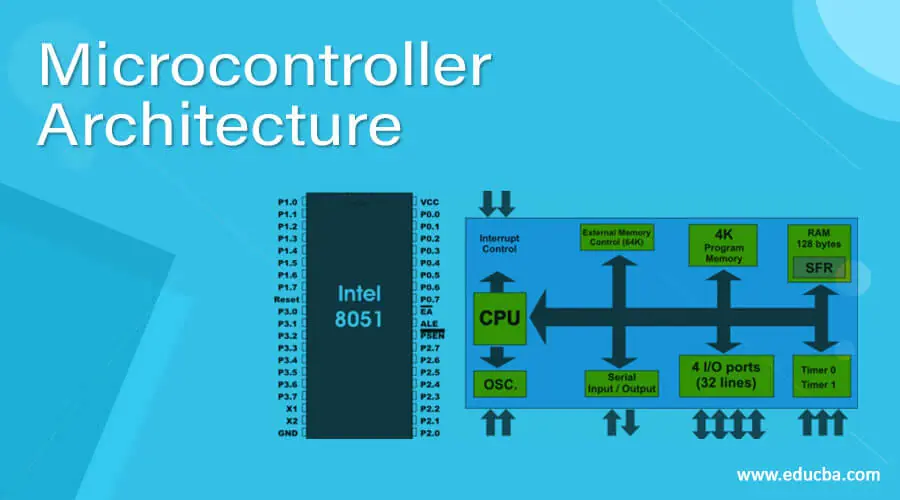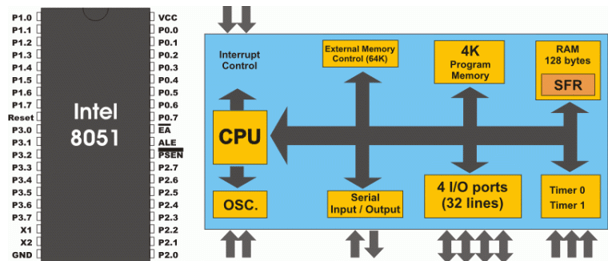
Introduction to Microcontroller Architecture
A Microcontroller is particularly a small computer. It can be said to be a chip that has memory. It can also be programmed so that it can do calculations. It can also receive inputs and generate outputs. In whichever device the controller have to exercise a certain degree of control, microcontrollers are present. They display characters of different types and integers on an LCD display of any appliance in use. The gadgets which need the processing of processes like measurement, control, display of information, and calculation of values have a microcontroller chip inside of them. In today’s world, they are present in most of the devices which we use at home and in work places.
Working of Microcontroller Architecture
The fundamental and primary part of the microcontroller is the Central Processing Unit which is capable of processing a word length that ranges between 4-bit up to 64-bit. But in modern-day technological developments, the word length has increased and accordingly the range. There is additionally a timer which is present in the microcontroller. It acts as a watchdog. There are memory storages of different types that are present in the microcontroller. They act as storage devices.
The architecture of the microcontroller is the internal hardware design which is important to understand the applicability of its architecture for different reasons. The design is not too complex and is easy to understand. The architecture defines every section very clearly and distinctly.
Components of a Microcontroller
Let us look at the basic components of a Microcontroller:
1. CPU (Central Processing Unit)
It comprises of an Arithmetic Logic Unit (ALU) and also a Control Unit (CU) and some other components too which are important for its functioning. It is the main or primary device and co-ordinates the communication between the peripheral devices such as memory, Output, and also Input. All the arithmetical and logical operations are performed by the Arithmetic Logic Unit (ALU). The timing to be maintained of the communication between the CPU and the different components in the device is controlled by the Control Unit (CU).
2. Program Memory
Whatever instructions are given by the CPU are recorded and stored in the Program Memory. On a usual note, it is also termed as Read-Only Memory (ROM). It even stores the data whenever the device is not in functioning mode or is turned off so that there is a stored record of the functions and the implementation of the various actions of the device controls. Even on the possibility of a complete reset, there is no alteration of any data. The modern modules of Program Memory are actually made up of Electrically Erasable Programmable Read-Only Memory (EEPROM) which is also non-volatile memory. Popular Course in this categoryWindows 10 Training (4 Courses, 4+ Projects)4 Online Courses | 4 Hands-On Projects | 26+ Hours | Verifiable Certificate of Completion | Lifetime Access
4.5 (6,382 ratings)Course Price
₹4999 ₹27999
View Course
Related CoursesJWS Java Web Services Training (4 Courses, 11 Projects)Java Training (40 Courses, 29 Projects, 4 Quizzes)
3. Data Memory
It is in the microcontroller and is totally responsible for the storage of values of temporary data and variables. It also stores intermediate results and some other data which are important for the proper functioning of the program. It is commonly called as Random Access Memory (RAM) and is a volatile memory. It is commonly systematized as registers and it includes the Special Function Registers (SFRs) and also the memory locations accessible by the user.
4. Input and Output Ports
These ports are the ones that provide the physical connection of the microcontroller to the world outside. There are sensors that are present in the ports and they assist in allowing the input of data from external sources into the microcontroller. The data which is received from the input ports is usually manipulated and that is what will decide the data which will be on the output port. Mostly, the ports present in the microcontroller function both as input and also as output ports. They perform dual functionality.
5. Clock Generator (Oscillator)
The synchronization of data and the flow of the commands need to be sincere and orderly. The clock signal helps in this important functioning of the microcontroller. The operations thereby run very smoothly. It is an integral and important part of the microcontroller and its architecture. An additional timing circuit needs to be provided which has to be in the form of a Crystal.
6. Analog to Digital Converter (ADC) and Digital to Analog Converter (DAC)
These converters are very useful to convert the output signal in the necessary altered form. For instance, the data which is available in the form of analog signal can be converted into the form of digital and vice-versa.
Diagram of the Microcontroller Architecture

This image of Intel 8051 describes the details of the above-mentioned architecture points
Features of a Microcontroller
- The modern microcontrollers are built with a Complex Instruction Set Computer (CISC) inside of them. The benefit of this is that the instructions are macro-type. It can be used to replace a number of instructions together.
- The new technology has helped to make microcontrollers that consume very less power. Commonly, they support voltage of 1.8-5.5 V
- The microcontrollers are very user friendly and also quite reliable because they use advanced memory. ROM memories which are high-end benefits of technological improvements like EEPROM are better and much more capable in storage functions. It also allows for more erase/write cycles.
Advantages and Disadvantages of a Microcontroller
| Advantages | Disadvantages |
| Design is more compact and easy to use. | They have a complex architecture. |
| The cost of a microcontroller is very cheap. | They are not suitable for high power devices. |
| All the pins which are present in the microcontroller can be programmed. | They can perform only limited operations at the same time. |
| The interfacing of the ROM, RAM, and also the I/O ports is very simple and easy. | It is generally used only in any micro equipment. |
| Troubleshooting is quick, easy, and convenient. | It has limitations on the capacity of the storage of data. |
| Data is stored well and even on reset it won’t be erased. | It can overheat very quickly since it is tiny and has a complex set of peripherals. |
Conclusion – Microcontroller Architecture
Microcontroller is a very convenient processing tool. The architecture clearly defines the specialty of the microprocessor and at the same time it carries along with a few disadvantages in usage. But for the small devices or microdevices they are very useful and convenient. Also, the fact that they have been upgraded and are always on the process of new developments of the peripherals inside of them, is bound to be an impressive thing to use in micro appliances.
Recommended Articles
This has been a guide to Microcontroller Architecture. Here we discuss the introduction of Microcontroller Architecture, components, features, advantages, and disadvantages. You may also look at the following article to learn more –
